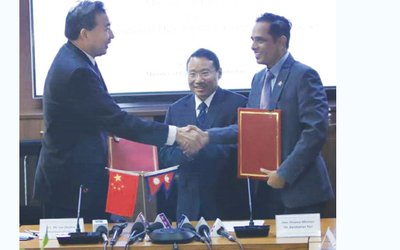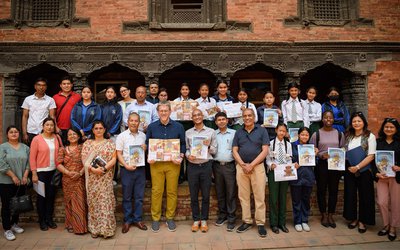The EU-funded Trade and Private Sector Development (TPSD) program, in cooperation with Ministry of Commerce as Implementing Agency and the Department of Food Technology and Quality Control (DFTQC) a key counterpart conducts an extensive capacity building project on Good Manufacturing Practice (GMP), Good Hygiene Practice (GHP) and Hazard Analysis Critical Control Points (HACCP) in the dairy sector.
The dairy sector has an important potential to contribute to economic growth and poverty reduction in Nepal. It is one of five value chains prioritized in the Agricultural Development Strategy. About 500,000 households are engaged in the dairy market as producers and sellers of milk.
During a seminar on 30 May 2016 participants from the private sector were familiarized with new guidelines, which will help food inspectors to enhance quality in the dairy sector. The TPSD program together with DFTQC also launched a pilot project to assist four to five dairy enterprises in implementing GMP, GHP and HACCP. This is expected to begin in September 2016.
Sanjeev Kumar Karn, DFTQC Director General, noted during the event that milk products are a rich and convenient source of nutrients provided that food safety and quality standards are properly applied. These standards also enhance competitiveness of Nepalese dairy products in the domestic and international export markets. "Therefore, everybody concerned in the milk business including farmers, milk collectors, manufacturers, processors, handlers, and distributors have their respective roles and responsibilities to ensure that the milk is safe for human consumption" Karn added. He welcomed the support of the EU to DFTQC and the dairy sector.
Meanwhile Andreas Roettger, Head of Cooperation of the EU Delegation said: "A more systematic approach to quality control can expand productivity and market opportunities with healthier, tastier dairy products and it offers more and better choices to the consumers. In addition, such approach can save energy, lower the carbon footprint and save costs. We are happy to have joined hands with the Government towards a more effective implementation of GHP, GMP and HACCP standards".
The 6 million Euro TPSD program closely works together with the Government of Nepal and organizations representing producers, exporters and importers. It covers key themes such as trade policy and capacity building, quality infrastructure and value chain development. GMP, GHP, and HACCP form a preventive food safety risk management system in which every step in the manufacture, storage and distribution of milk and dairy products is analyzed for microbiological, physical and chemical hazards. HACCP provides businesses with a cost effective system to ensure food safety covering the stages from production to distribution of food and lowering the carbon footprint by using less energy along the value chain. The preventive approach of HACCP improves food safety and food quality standards in compliance with the best practices and international standards and in the long run it increases productivity, and improves competitiveness in the domestic and export markets.
All foods have the potential to cause food borne illness and milk and milks products are no exception. The contamination of milk can occur during production, processing, handling and distribution. Dairy animals may carry human pathogens. Such pathogens present in milk may increase the risk of food borne disease. Moreover, the milking procedure, subsequent cooling and the storage of milk carry the risks of further contamination from man or the environment or growth of inherent pathogens. Implementing the proper hygienic control of milk and milk products throughout the food chain is essential to ensure the safety and suitability of these foods for their intended use.
The DFTQC is working in collaboration with the EU-funded TPSD project on a capacity building pilot program to implement GMP, GHP and HACCP in order to promote adoption of these standards throughout the dairy sector.
The dairy sector offers regular cash income to smallholders as well as a ready supply of nutritious dairy products, meat (in the case of buffalo), manure, and farm power for cultivation. Smallholder dairy farmers’ production in Nepal is mainly aggregated through dairy cooperatives. According to reports, there are about 1,735 dairy cooperatives in Nepal, Member cooperatives are functioning as the primary supplier of milk to the formal dairy processing sectors. It is estimated that almost 90% of total milk handled by the formal dairy processing industry comes through cooperatives. According to the Dairy Industries Association the sector produces daily about 4.8 million liters daily of which 15 percent is processed by large dairies, 35 percent processed by small dairies and the remainder consumed at farm or village level. Twenty thousand people work in the dairy sector which is worth about 15 billion rupees in annual output. Currently the diary sector faces a trade deficit. Imports are estimated at just under one billion rupees while exports are negligible.
- TANAHU HYDROPOWER PROEJCT: A Significant Achievement
- Apr 15, 2024
- AMBASSADOR HANAN GODAR: Sharing Pain With A Nepali Family
- Mar 30, 2024
- VISIT OF KfW AND EIB TO NEPAL : Mission Matters
- Mar 25, 2024
- NEPAL BRITAIN SOCIETY: Pratima Pande's Leadership
- Mar 24, 2024
- NEPAL ARMY DAY: Time To Recall Glory
- Mar 15, 2024
















